The Great Long Beach Earthquake of 1933 was a huge wake up call for Southern California. It occurred just a little under 20 years after the infamous 1906 San Francisco Earthquake on March 10, 1933 at 5:54 pm. What may be odd is that the coordinates for this cache are in Newport Beach, not Long Beach. Well, back in 1933 most of Orange County was farmland and the largest nearby city was Long Beach, where most people felt the shaking. The name of the earthquake was formally giving as the Long Beach Earthquake, not the Newport Beach earthquake as Newport Beach didn't exist yet. The epicenter is about a mile offshore from this location. The quake measured a 6.4 on the moment magnitude scale and was felt in three states and Mexico. I'll talk about how earthquake magnitudes are measured later on in this earthcache. It lasted no more than a few seconds, but caused nearly every unreinforced building in Southern California to collapse, causing the deaths of 115 to 120 people. Luckily, the earthquake occurred after school hours, otherwise the death toll would have been higher.
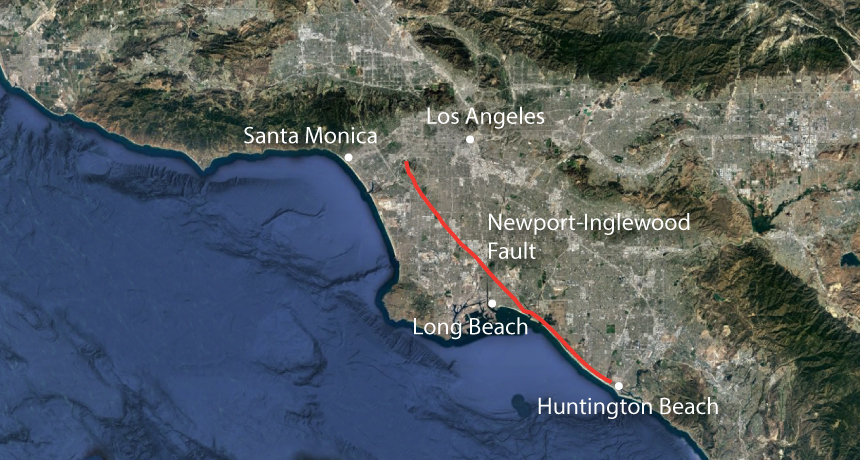
The earthquake happened along a section of the Newport-Inglwood Fault, which runs parallel to the coastline in Orange County, before making land fall just north of Seal Beach. The fault is just one of many which run parallel to the infamous San Andreas Fault, about 60 miles west of here. Most faults in Southern California run parallel to this due to stress cracks forming in parallel lines and new faults are born.
Now that you've had your history lesson, it's time for a geology lesson. Lets first discus the main types of plates. There are oceanic plates and there are continental plates. Oceanic plates are made up of mafic rocks, meaning they are low in silica (SiO2) and appear dark in color. Oceanic plates are mostly made up of basalt due to the divergent plate boundary creating new land. I'll get to what a divergent plate boundary is in the next paragraph. Continental plates are made up of mostly granitic type rocks and are mostly felsic, or appear light in color due to their high silica content.
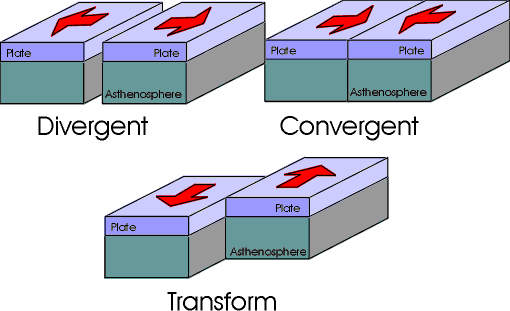
Now that you are familiar with plates, we can discuss how they interact with each other. There are three main plate boundaries called convergent, divergent, and transverse (transform). A convergent plate boundary is when two plates collide. Think of it as a head on collision in a car crash. There are two types of convergent plate boundaries. One type is called subduction, where one plate slides under another which almost always occur off the coast of a continent. The plate that subducts is always an oceanic plate because it's more dense due to basalt being more dense than granite. There are more atoms per square inch in basalt than in granite, making it more dense and more heavy. Hence objects tend to sink towards the bottom like a penny in a glass of water. Lighter objects will float like an ice cube. Ice cubes can move around in the surface of the water, like how tectonic plates move and interact.
Divergent plate boundary are when two plates move away from each other. These happen almost always in oceanic plates because they are much thiner than continental plates, more easily to tear apart. It's easier to rip a tortilla than a pizza. In the ocean, we call these mid-ocean ridges. They create mountains in the ocean. As lava pours out and hardens, new lava flows on top and so on. It's like a scab. Its height keeps growing. Sometimes it even reaches the surface of the ocean. Iceland is a great example where you can literally stand in the mid-ocean ridge.
Transverse, transform, or strike-strip plate boundaries whose names are synonymous, slide passed each other. The San Andreas Fault is a transform fault, and same with the Newport-Inglewood Fault. Most transform faults occur in the ocean because it's hard to rip continental crust from side to side due to it's thickness. The San Andreas Fault and its associated faults is a rare and unique exception. There are two types of transform faults and it depends on how you view it. One is called a left-latteral strike-strip fault and the other a right-lateral strike-strip fault. To know the difference, you can observe the direction of relative movement. If you are on one side of the plate, looking towards the other and the land moves to your left then it's a left-lateral strike-strip fault. Likewise, if the land moves to your right, it's a right-lateral strike-strip fault. Seems easy enough, right?
Now that you are familiar with the different types of faults, we can discus as to why they move and the forces behind it. The answer can be found in your kitchen, literally. When boiling pasta on the stove, the hotter pasta floats to the surface then when it cools it sinks. This effect has a name. Convection currents in your pot at home and in the earth are nearly identical. There are a few difference though. One is with water, rather than boiling rocks and the other is that one is less a few inches while one is miles deep. Convection currents are continues cycles in the earth's mantel that make hotter rock rise, and cooler rock fall and the cycle begins over and over again. When this happens, it causes fractures in the earth's crust. When fractures occur, a fault line is created.
Now at this point I'm sure you are asking, "What is a fault line?" Well it's more of a fault zone since it's a collection of cracks rather than one single crack. Simplicity, it is place where two tectonic plates meet and create friction. When this friction is released, an earthquake is formed. This friction is formed by these convection currents. When they move in a circular pattern in one direction, they can push rock with them. When tension is released you get an earthquake that moves in waves on the X, Y, and Z axises. X is up or down, Y is right or left, and Z is pivoting side to side. There are a few types of earthquake waves which I'll go into detail.
When an earthquake occurs, the all the types of waves are produced at once. But these different waves move at different velocities in different fluids. Fluids such as hard rock can pass energy more efficiently than softer rock. Because the west coast of California is generally made up of soft, sedimentary rock, it absorbs more energy from these waves then if it was a hard rock like granite. It's the reason why a 5.0 earthquake in Virgina in 2011 was felt across the entire east coast. Most rocks there are hard granitic types which transfer more energy efficently. When a 5.0 happens in California, it is only felt no more than 150 miles from the epicenter. Because earthquake waves move at different velocities, they arrive at different times at any specific point on earth. This time difference helps geologists determine the exact epicenter within a few meters of accuracy.
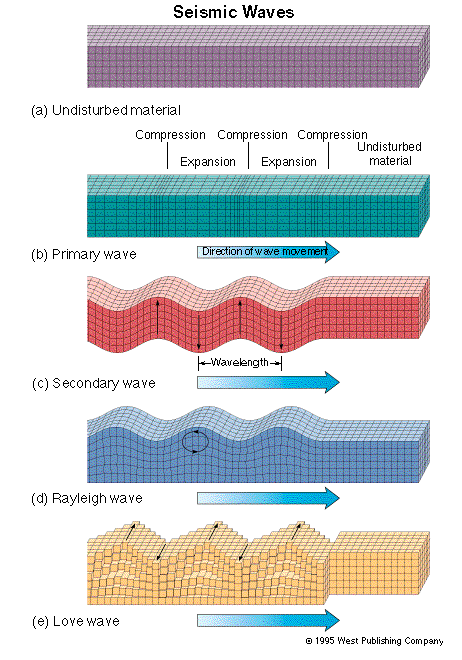
There are two types of seismic waves which are called body and surface waves. Body waves travel in the interior of the earth and bounce back to the surface and so on. Depending on different types of rocks and their densities, these raves can be refracted like a rainbow. Body waves can bend downward and upward as they travel through the earth. Surfaces waves, on the other hand, can only travel on the surface. Because of this, they take less travel time and are the first to arrive from the epicenter.
There are two types of surface waves which are called primary (P-wave) and secondary (S-wave). Primary waves are the first seismic waves to arrive during an earthquake, hence the name. They are compressional waves, meaning the particles expand and contract on the horizontal axis. An example would be stretching a slinky and pushing it back to gather. Secondary waves move in the opposite direction. After the P-wave has passed, the S-wave will move particles up and down vertically similar to jumping up and down where your only motion is vertical.
There are two main types of body waves which are called Love and Rayleigh waves. Love waves travel faster than Rayleigh waves and they do the most damage to structures. Body waves are what you feel when an earthquake is occurring. Rarely do you feel surface waves. Love waves move side to side, but in a perpendicular angle of the direction of the wave. The push and pull objects from side to side. It's the most destructive because they shake violently. Rayleigh waves roll the land like a wave at the beach. They pick up an object pull it forward and pull it back before setting it right where it started. When you feel a rolling motion in an earthquake, it's a Rayleigh wave. An easy way to remember the difference between them is that the "L" in love waves makes a 90 degree angle in the direction of the wave. Rayleigh waves roll, so just think what type of motion an "R" makes, especially if you are a Spanish speaker who rolls their "R"s a lot.
Earthquakes have another, even more destructive force called liquefaction.Liquefaction is literally turning the ground into quick sand. Buildings are not being supported by anything so they ultimately fall and sink in this water. To understand liquefaction, think of it like a water bottle with water at the bottom and dry sand at the top. When you shake it, water travels up to the surface as the sand settles. What really happens is that when you shake and bottle full of sand, the elevation gets lower due to small particles of sand go under the larger ones. In reality, this squeezes up groundwater to the surface which makes puddles and can deform the land up to a few feet.
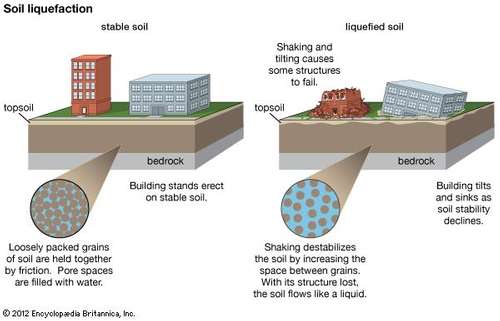
Knowing the types of earthquake waves will help you determine the magnitude. There are three ways in which that can be done. The first type of modern measuring of earthquakes was developed by Giuseppe Mercalli, an Italian volcanologist, in the late 1800s. The Mercalli scale, or today called the Modified Mercalli scale uses eye witness accounts of the shaking and damages to draw a visual map of damage and relative shaking from a general point. Given many interviews and surveys of the damage, a relative map could be made of the intensity of the shaking. It was meant to measure intensity, not angry realized so for deep earthquakes it was highly inaccurate since depth wasn't a factor in determining a number. The number scale is written in roman numerals to differentiate it from other methods of measurement. Numbers go from I (not felt) to XII (extreme) for a total of 12 numerical values.
Before the invention of the modern seismograph in the 1900s, we could only guesstimate the magnitude of an earthquake with no mathematical measurements. So only a relative number based off of interviews and surveys wouldn't be accurate, hence why there is a disagreement with large earthquakes before the Richter Scale, the next magnitude measurement scale I'll talk about. There isn't a definitive answer as to how big the 1906 earthquake was due to this lack of information. It wasn't until Charles Richter, a seismologist professor at California Institute of Technology in Pasadena invented his own system in 1939.
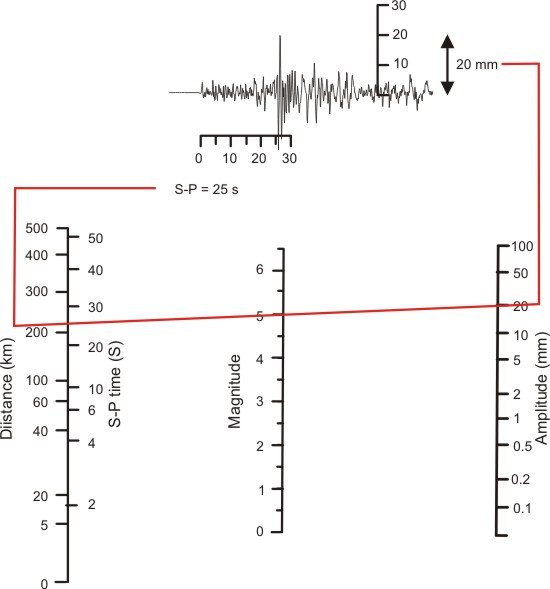
The Richter scale was intended to measure the magnitude of earthquakes based on energy released by measuring the largest wave produced on a seismometer and drawing a chart based on fixed proportions. I'll explain how a seismometer works in a few paragraphs. It was intended to measure earthquakes in California, since all the rocks are nearly the same. The scale was logarithmic (see above), meaning that each increasing number would be about 32 times greater, in terms of energy released, than the previous one. Theoretically, there is no number that an earthquake can be measured at. But, looking at passed measurements the scale has only measured earthquakes no more than a 10. The Richter scale was the first accurate way to give a magnitude to an earthquake, but it too had it's draw backs. For one, it didn't take into account the type of rocks, depths, pressures, or type of faulting. The Richter Scale would usually cap out around a 7 or 8 meaning that for very large earthquakes, this scale was not accurate. It became time to develop a new method to measure earthquakes, that took every little variable into account.
The Moment Magnitude Scale (below) measures earthquakes in terms of energy released based on a number of factors. It took into account the area of the fault plane that had shifted as well as the rigidity of the rocks, or the hardness. It also took into account the type of movement of the fault plane. It took a long time to calculate and retrieve all the data, but in the end it is way more accurate. The Ricther Scale, in contrast, had not enough variables and is easy to calculate based on actual recordable data. The Moment Magnitude Scale has a rating from 1 to 10, but like it's predecessor there is no end limit as to how energetic an earthquake can get. Think of it like this: Richter is a fixed number scale, while Moment Magnitude is an infinite scale.
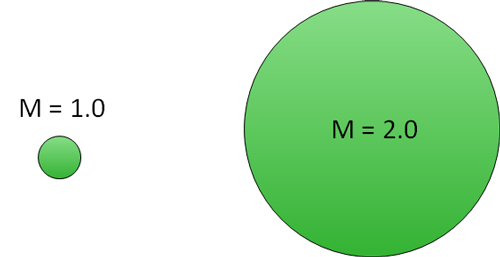
Today, the most common ways to measure earthquakes are the Richter Scale and the Moment Magnitude Scale. In order to differentiated these from each other, they were given a small call sign in front of the number they represent. All earthquakes measured using the Richter Scale have an (ML) where the L is a sub letter. All earthquakes measured using the Moment Magnitude Scale have an (MW) where the W is a sub letter. Seismographs help geologist determine the intensity as well as the epicenter and focus of an earthquake.
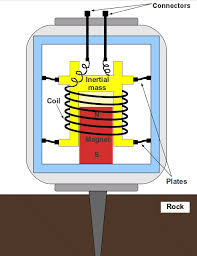
Seismographs work by creating electricity. Inside each modern seismometer, are three small gyroscopes. One is placed in the vertical direction, one is placed in the horizontal direction and one in the front and back direction. They are placed like this so that they cover the three main planes of motion the X, Y, and Z axises. When an earthquake happens, a seismometer will move with the ground it is buried in. Because the gyroscopes had a coper wire in the middle, it sends electrical signals to a transmitter as the seismometer moves and the gyroscopes stay in their resting positions. The signal is transmitter to a receiver where a seismograph can record the data. When an earthquake happens and you see a graph with a pen and moving paper, that's what has been recored from a seismometer. The P-waves come first, followed by a small break before the S-waves arrive. Rayleigh waves are next followed by Love waves. Because the gyroscopes are set in each axis, we can easily determine the type of wave that is being recorded.
The difference between the arrival of the P and S (seen below) waves will tell us the epicenter and focus of the earthquake. We know the velocities of the P and S wave are fixed, so if we know the time difference between them we can calculate a distance. You need at least three seismometers placed in just the right spots ignored to know where the epicenter is. Let's say that you calculated the distance from the epicenter to three different seismometers. Station A has a distance of 50 miles. Station B, 100. And Station C, 150. From each station, you'd draw a three-dimensional sphere of those distances at each station. Where they all intersect in the ground is the focus, the exact point where the earthquake began. Where that point lies directly above the ground is the epicenter of the earthquake.
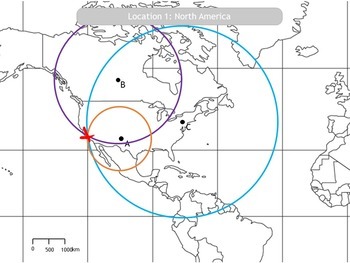
The San Andreas Fault is roughly 20-25 million years old. Before then, the west coast of California was an active subduction zone where the Farallon Plate subjected under the North American Plate, creating volcanoes in the present day Sierra Nevada. What's left of those ancient volcanoes are the granite monoliths. Half Dome and El Capitan are the most notable.
When subduction ceased here it created two knew plates that can still be seen today as the Juan de Fuca plate off the coasts of Northern California, Oregon, Washington, and British Columbia. It is this plate that still is being subjected under the North American Plate that creates the Cascade Volcanoes. The other plate is known as the Cocos Plate in Central America. Each plate were technically the same at one point, but they were discovered before this connection was made, hence why the different names of these plates. Back in California, the tension began to tear the boundary between the Pacific Plate and the North American Plate. The end result was a new type of plate boundary, a transform fault called the San Andreas. Over millions of years, the fault grew, eventually becoming nearly 800 miles long from just south of Eureka, California to the Salton Sea, just east of San Diego. This new fault would become the world's most famous, especially since it was the responsible for the 1906 earthquake. Since the San Andreas Fault's creation, many more faults were made in it's wake. The Newport-Inglewood Fault, for example, was one of them.
Works Cited
http://www.scienceinschool.org/2012/issue23/earthquakes
https://www.tes.com/lessons/ZuyWtedW6iv9Mw/types-of-plate-boundaries
https://www.esgsolutions.com/technical-resources/microseismic-knowledgebase/what-is-moment-magnitude
http://www.bgs.ac.uk/discoveringGeology/hazards/earthquakes/MeasuringQuakes.html
https://web.archive.org/web/20060211010253/https://earthquake.usgs.gov/regional/states/events/1933_03_11.php
https://www.sciencenews.org/article/seismologists-surprised-deep-california-quakes
TO LOG A FIND ON THIS CACHE YOU MUST GIVE ME THE CORECT ANSWERS. YOU CAN CONTACT ME THROUGH MY EMAIL OR THE GEOCACHING MESSAGE CENTER. ANY INCORRECT ANSWERS WILL RESULT IN A DELETED LOG
1. "1933 Long Beach Earthquake Epicenter" on the first line of your email AND list all geocaching names of your party so I can match your answers to them.
2. If you were standing at (a) GZ, (b) Long Beach, (c) Los Angeles, (d) San Diego on March 10, 1933 at about 5:54 pm, name the type of seismic waves that would reach you in order AND explain why this is always a constant variable.
3. Based on your knowledge of liquefaction, pick at least one area or place from this vantage point that would be at the greatest risk AND explain why.
4. Would a tsunami happen if the Newport-Inglewood Fault ruptured offshore again like it did in 1933? Is there a current tsunami threat from the Newport-Inglewood Fault? Explain your reasoning.
5. If a tsunami did happen, Tell me (a) how has the city prepared the coastline, (b) what obstacles are here now that could slow down an impeding wave, (c) what is missing that the city could build or add, and (d) how these different measures would slow down or stop a tsunami if implanted correctly.
6. Look around the surround area of GZ. Where would you place a seismometer based on your geologic knowledge? Mark the location by either street locations or GPS coordinates and explain why it might be a good place to add one, considering hazards that could damage or impede on accurate data such as liquefaction.